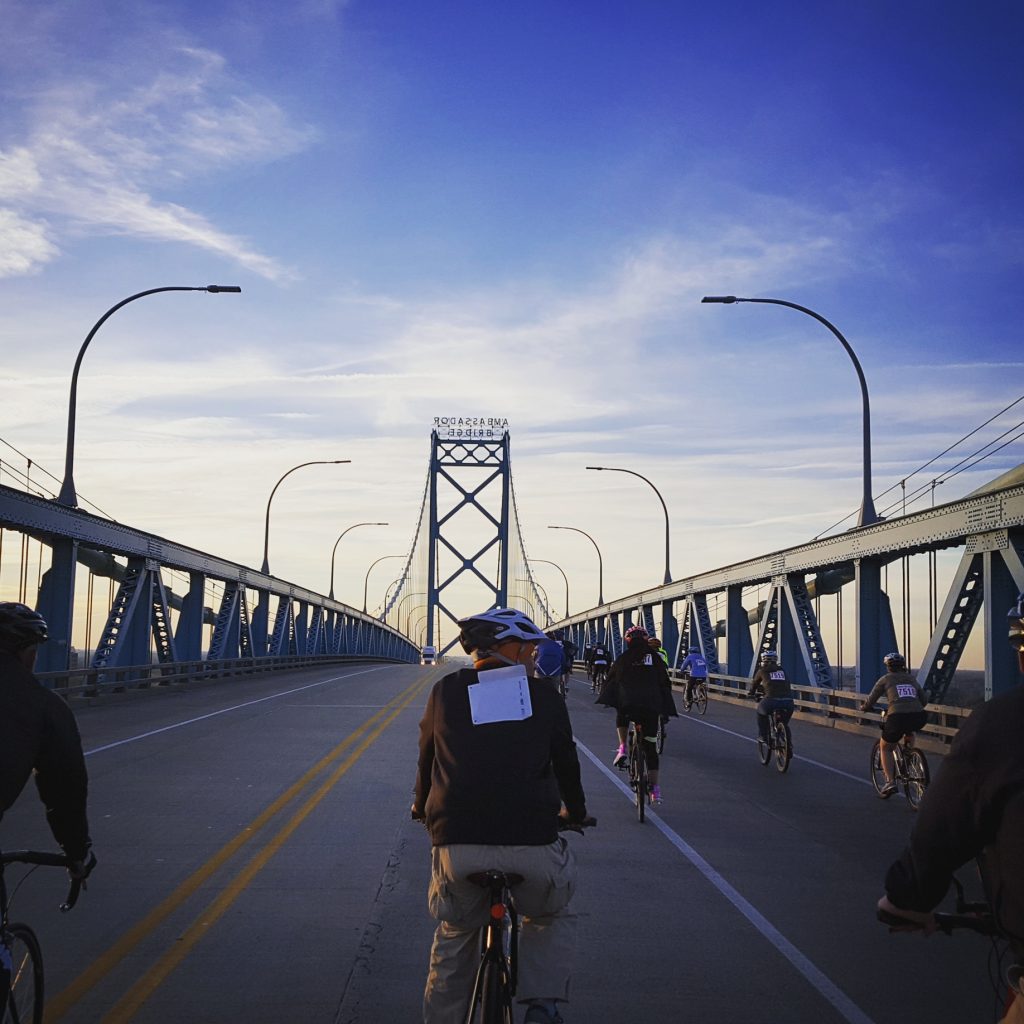Bike The Bridge: Fleeting Dreams of International Bike Transit
On Sunday, for the first and possibly the last time, I rode my bike across the Detroit River on the Ambassador Bridge. It was a lot of fun, but also a reminder of how badly in need of a revamp our border crossing is, both rega rding international transit modality and the culture and processes of border security.
rding international transit modality and the culture and processes of border security.
The ride was fun, but brief– we were not afforded the opportunity to actually ride around Windsor at all, which was kind of lame, and instead just had to turn around at the base of the bridge. An army of well-armed CBP officers made sure we didn’t stop to take pictures, stop, or slow down too much, because terrorism.
I’ve probably crossed the Windsor-Detroit border hundreds of times. I dated a Canadian for about a year, and even though we broke up, I got to keep the trivia team, which I visit every Monday night (we pretty much always win 4th place).
Plenty of Detroiters don’t visit Windsor, complaining about how they used to go there, but then 9/11 happened, and you had to have a passport to cross (you don’t), but they do point out that it is much more of a pain in the ass, especially coming back into the United States, where I’ve been asked why on earth I would ever move to Detroit (I asked, “why would you ever move to Macomb County?”, why I feel the need to spend money at a bar in a foreign country when I could spend it in the United States, why I have a bike rack on my car, why I had a Bernie Sanders sticker on my old car.
It’s a messed up culture of fear and paranoia– Canada is our biggest trading partner and, as such, we share many common cultural and economic narratives. But I can’t fix that issue short of dismantling nearly a generation-long era of post-Cold War paranoia that has come to define the law enforcement officials who commute in from the distant suburbs every shift to interrogate American and Canadian citizens alike about what on earth they might be doing, going about their daily business.
So, getting past the problem of a perpetually inadequate number of lanes open on either side, which means wait times, we have to also think about alternatives for crossing. The only way to cross without a personal vehicle is with a taxi (expensive) or on the tunnel bus, a Windsor Transit-operated line, which has an extremely unreliable schedule and route. The tunnel bus is a good option during major sporting events, but Detroiters and Windsorites, headed, respectively, to Caesar’s Windsor or one of Detroit’s publicly-funded sportsball arenas, are still reliant on the automobile, so forget a bus– especially one jammed to capacity that runs behind schedule because the tunnel is so clogged up during these major events.
What about a bike? It takes up way less space than a car, it imposes less wear on infrastructure, and it’s affordable to operate. The Gordie Howe Bridge will supposedly include bike lanes, but that’s a solid few miles from downtown– it isn’t exactly a direct link between our two great nations. We do, however, remember that unsung hero, Windsorite Kyle Colasanti, who biked through the tunnel to get to a Steely Dan concert, much to the chagrin of Customs and Border Patrol officers, who really were pissed that he wasn’t driving an F250 Super Duty and detained him for hours for no reason (go figure).
Kyle acted on what most of us are thinking– that we need better bike transport.

And why we need a better border crossing– not just in terms of international transit modes but also the ownership and fees. Joann Mueller wrote an excellent article about why the Ambassador’s situation is so utterly screwed up– how the monopolistic ownership has resulted in the doubling or even quadrupling of tolls, how delays in truck traffic cost the US-Canadian trade economy hundreds of millions of dollars a year (and, frankly, result in clouds of heavy particulate diesel exhaust stinking up Southwest Detroit, which is already not exactly an atmospheric paradise owing to the heavy industry around the Rouge River and Zug Island).
It is unclear how much this will change with the Gordie Howe Bridge, either in terms of air pollution, reduction of traffic on the Ambassador Bridge, or potential future uses of the old Ambassador Bridge once Moroun finally gets his way and gets a new span built. But one thing is for certain– demand for bike infrastructure is increasing at the same time that even the auto industry is shifting away from internal combustion vehicles. Examples include GM’s shocker that it will introduce a bazillion electric cars by 2023, or diesel engine heavyweight Cummins, which announced an all-electric semi under development for sale starting in 2019.

